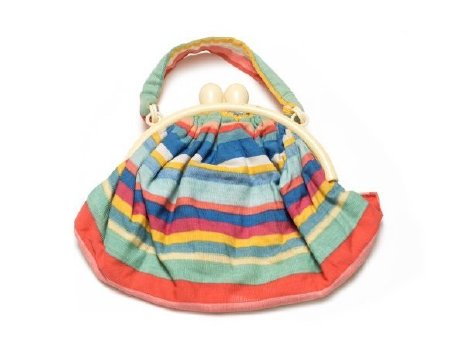Object ID:
2016.4.4
Label/Maker:
Unknown
Date:
1945-1959
Object Details:
With whimsically bold and bright horizontal stripes in a knit fabric, this purse was modeled from a Bermuda bag which was considered an integral part of an ensemble. In the post-war years, the demand for handbags in the mid-1940s increased as women were inclined to carry grooming products as well as essential items such as coin purses, handkerchiefs, gloves, and mirrors. This accessory took on many new functional styles intended for a variety of occasions that ranged in size and shape. "In place of metal handles and fastenings, Bakelite and plastics were often used." These materials provided a functional substitute, while creating attractive designs used for both day and evening wear which are evident in this handbag.22 The shorter handle aligns with utilitarian styles in the 1950s that often coordinated with outfits.
Reference:
Compare to this record: Ackermann Fashion Plate
Cultural Connections:
With the mechanization of textile production, during the latter part of the 18th century, the development of patterns including stripes became stylish. Before striped textiles evolved, they were initially a sign of expulsion. French social historian Michel Pastoureau writes that, in the European Middle Ages, striped cloth took on strong connotations of deviance and abasement.23 However, as society moved toward the industrial era of the 19th century, this pattern took on new meaning. Here, the empire silhouette has further connotations of boldness and daringness, including a willingness to test the boundaries of social tolerance. Fast forward to 1917 when Coco Chanel launched jersey knit tops for women with horizontal stripes inspired by sailor uniforms and menswear. This modern style provided freedom for women who did not always want to dress in lace and frills. Striped textiles would also find fashionable positioning during the post WWII era. For example, in the late 1940s, stripes were commonly worn in a variety of color combinations including blue, red, brown, green, pink, and yellow for summer fashions. As the 1950s progressed, the striped shirt became a part of youth culture and was disseminated through television and film worn by actresses Audrey Hepburn and Brigette Bardot. Like the evening dress of the early 19th century, a modern vintage purse conveys a bold presence through prominently positioned stripes, which expressed societal conditions and fashion trends during the periods in which they were created.
Reference:
22 "1940s Handbags and Purses Fashion," Vintage Dancer, January 10, 2017. https://vintagedancer.com/1940s/1940s-handbags-purses-history/
23 "History of Famous Cloth Patterns: Stripes," Fashionologia Historiana, February 11, 2018.
23 "History of Famous Cloth Patterns: Stripes," Fashionologia Historiana, February 11, 2018.

